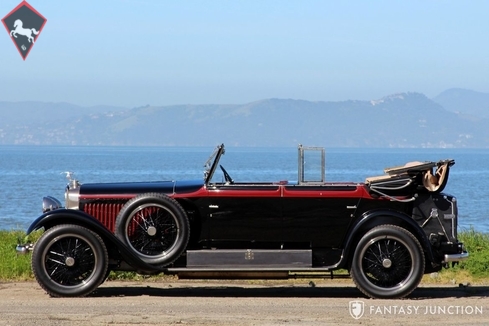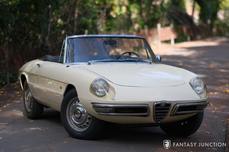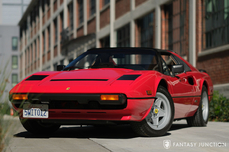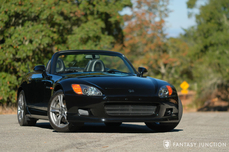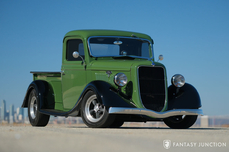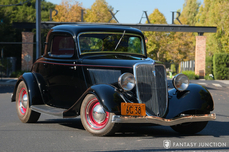Hispano-Suiza K6 6597 c.c. Inline 6-cylinder 1925
General description :
1925 Hispano-Suiza H6B Convertible Sedan Coachwork by Belvallette
s/n 11093, Eng. no. 301111, Body no. 9899
Black with Maroon Leather and Highlights
The luxurious and elegant Hispano-Suiza came to fruition at a time in automobile development when industry was booming and individual wealth was increasing at historic rates. Chosen by European royalty, Maharajahs, Hollywood film stars and industrial tycoons, the legendary Hispano-Suiza was brilliantly engineered, adorned with beautiful fixtures, and stunning handmade coachwork. Swiss engineer Marc Birkigt had proven his capabilities with Hispano-Suiza-engined Spad fighter planes in World War I, devising a lightweight aluminum casting with steel liners, essentially creating the first block castings of their type. After the war, Hispano-Suiza delivered the same brilliance to the new H6 cars built in Paris at the Bois Colombes factory, unveiled in 1919, with the H6B model revealed in 1920.
Captain Georges Guynemer's Stork Squadron of Hispano-Suiza-engined Spads became the mascot adorning the H6 radiator, featuring a six-cylinder car of 6,597cc capacity. The model was renowned for its ease of handling, engine efficiency, durable three-speed gearbox, and advanced servo-assisted four-wheel power brakes. So significant were the technical and engineering applications, that many rival companies licensed Hispano-Suiza patents for use on their cars; Rolls-Royce being one of many. Hispano-Suiza was proud to offer their aero-engineering technology, their attention to detail, and motoring refinement to the world stage. Rolls-Royce, Isotta-Fraschini and Pierce-Arrow became eagerly aware of the challenge, particularly to discerning and wealthy clientele. After World War II, Hispano-Suiza would thrive, however focusing their efforts primarily in aerospace, making their pre-war cars not only astonishingly beautiful expressions of luxury, but rare and desirable among collectors and enthusiasts of fine motorcars.
Continental European automobile manufacturing emerged as engineering and coachwork combined to meet the needs of wealthy clientele. In these early years, it is important to note that cars were expressions of wealth and opulence, much as a stately manor or castle might be. It followed suit that the coachwork would have to resemble themes of elegance and refinement, yet be suitable for a range of affairs. Many wealthy car owners were known to have closed coachwork removed in the summer (replaced by open air designs) and returned again in winter to suit the motoring climate. And while this was a relatively easy operation, facilitated by the body-on-frame design of early cars, coachbuilders responded with more practical options by developing “transformable” bodywork, particularly suited to owners requiring 'town and country' use.
Belvallette of Paris, a long-standing family in the carriage trade, pioneered the fully convertible body, constructed trailers for motorized tricycles and quadricycles, and refined the application of transformable bodywork. In the mid-1920s, licensing Gustave Baehr’s patent, they offered a fully transformable design, capable of open and closed touring (contemporary copies of the original patent accompany the car). This fine example remains as one of the very few surviving Belvallette transformable designs, as featured on the luxurious Hispano-Suiza H6B chassis.
Current owner, Pebble Beach Chairman Emeritus and renown Hispano-Suiza expert Jules Heumann, has shaped the world’s most important concours event for four decades. His curatorial excellence and attention to detail, combined with impeccable taste is second to none. After owning multiple Hispano-Suizas he sold his last one and began a search, longing for another example. His search resulted in the stunning car offered here today.
Mr. Heumann’s research indicates that chassis 11093 was supplied as new with the engine it still carries, number 301111. It was purchased under order number 1854 through the agent or dealer 'Saint Didier' and sold to a 'M. de Surville' on 21 January 1925. It still wears the license plate designation of '30Y69', which is believed original to the car, placing the car's registration in the Rouen/Versailles region. Although the first 60 years of this elegant Hispano's life has remained largely a secret, it is understood and believed to have served the same family from new during this period, bearing the painted initials “JS” as it does today, adding to the aura of mystery surrounding the car. Shielded from public transactions for decades, in the summer of 1984 it emerged to be sold at a public auction in Paris. A contemporary advertisement in Le Figaro Magazine listed it as: Hispano Suiza, engine 301111, describing it as being 'de première main'. Noted as being unrestored, further evidenced by long-term ownership. Six years later, the car was offered at a second Paris auction in December 1990, appearing in largely the same condition, with a detailed description and photos indicating how original and authentic the car must have been, loosely translated as: "There is no better way to portray the exemplary 11093 H6 presented, than to say that it's unquestionable quality remains consistent in all respects to what it was originally. The last oil change was made in 1939 at 86930km. The counter indicates 89067km."
M. Claude Decoster of Neuilly purchased the car and subsequently commissioned famed Parisian Andre Le Coq to restore it to a high standard. Though entirely complete, the restoration was complicated by the detailed nature of the coachwork, requiring hundreds of dedicated hours perfecting even the smallest mechanical fitments and precision hardware. In 1992, the car was shown at the prestigious Louis Vuitton Classic at the Bagatelle in Paris, where it was awarded the Breitling 'Grand Prix de l'Innovation'.
Shortly after the award, famed connoisseur of automobiles (and particularly of Hispano-Suizas) Arturo Keller acquired the car and shipped it to America. The car remained with Keller until 2007, when he it traded for a Mercedes to Gerhard Raffay, the Porsche distributor for Germany and Poland. Mr. Heumann acquired the car in 2015 at the Bonhams Amelia Island Auction. Immediately after purchase, Mr. Heumann embarked on an astonishing mechanical restoration, details of which are only briefly outlined here, but are copiously documented and included with the purchase of the car.
Today the car exhibits a distinct maturity and stately manner imbued in the award-winning restoration and combined mechanical excellence achieved over many years of dedicated care under several thoughtful curators. The fascinating and beautifully constructed coachwork is exquisitely engineered, particularly considering the intricate mechanisms, which enable the glass and framing to be fully concealed. The gorgeous two-tone paint and deep gloss black finish have only mildly settled in recent years, showing minor evidence of use. The flowing fender line is accented by solid wheel construction, adorned with brightwork typical of the period, and impeccably polished to a gleaming luster. The interior is nothing short of breathtaking, revealing the finest leather upholstery and wooden cabinetry, tastefully and accurately restored to the highest standard by experts in the field. All this would be more than enough to satisfy any classic presentation, yet the Belvallette coachwork invites your imagination further with the wonderful transformable side glass, roof, and ingenious reconfigurable details. Among the many surprises, the rear side windows magically appear from their nested door pockets, delighting even the most hardened of automotive engineers and concourse aficionados. Then, with a push of a button, as though the first movement was not enough, the second movement of this mechanical symphony flips the glass pane forward, and firmly affixes it as the front side windows. The entire mechanism has automatic self-locking tabs, which allow each step of configuration to be securely locked, even at speed. Literally with a few clicks and switches, one seamlessly transforms the car from fully enclosed, to opera or landau position, or completely open, with or without any number or all of the side glass. Any of these configurations are easily executed, involving no electric power, and once mastered, become a delightful demonstration for smiling onlookers. The lasting impression this car delivers is one of awe and opulence - a fitting tribute to the era of original construction, captivating engineering, and a celebration of modern restoration arts.
As mentioned previously, the mechanical work performed over the past two years has been exhaustive. Mr. Heumann directed experts in all areas of mechanical excellence to refine and perfect this Hispano-Suiza allowing for reliable performance to compliment the superb aesthetics. What followed were multiple refinements, exhaustive searches for impossibly hard-to-find parts, and careful re-engineering resulting in expenditures of nearly $100k to achieve standards befitting such a fine car. To start the process, Mr. Heumann completely assessed the car and all mechanical systems. The 6,597cc OHC inline 6-cylinder engine with a single carburetor had been assembled in period with 4:1 compression pistons, in part to facilitate smoother engine use with older, less refined early fuels. The restoration process began with Larry Eisner and Jules Heumann carefully evaluating all systems, first by completely flushing the fuel system and replacing all parts as needed along with revitalizing the fuel system in preparation for the motor work. Fortunately a previous mechanical addition had been a stainless steel fuel tank and muffler. The decision was made to rebuild the engine and add additional power, accommodating modern fuels. Eisner and Heumann continued their ongoing restoration work on the car, removing and disassembling the engine for expert Phil Reilly. Rielly’s shop bored the engine to .030” oversize, and performed all machining work, allowing for new 7:1 pistons and rings, all new valves, valve springs, tappets, and keepers. Typical of the detailing and hand precision allowed in the mechanical work, the pistons alone required hours of precise machining to create a hollow at the tops, allowing for clearance of the spark plugs. The camshaft was checked by a specialist who determined that two of the lobes were worn .010”. The camshaft was then ground and hard chromed to achieve correct and uniformed dimensions. The lower end was tested revealing good oil pressure and thusly retained when the motor was reassembled. Reilly’s team then installed a Laycock type overdrive using the original 3-Speed Manual Transmission, making both the engine and passengers very comfortable for highway and touring use.
With the engine and all critical mechanical features now properly in order, the driving experience was addressed. Mr. Heumann had hoped to use the car in the 1000 mile Tour from Washington State to Pebble Beach. However the car required significant sorting and adjustments to the drive system. Properly sourced 23” wheels and 33x5” tires (fitting perfectly into the fender lines) solved some of the driveline challenges, but the correct sized hubs and proper lateral adjustments made to the rear axle were important features in an effort to tune the car at higher speeds; now critical with the new overdrive in place. Of course brakes and suspension were properly tuned and adjusted as needed, and all chassis points were properly lubed.
The exhaustive list of mechanical improvements is extensive, however some items of note bear mentioning for the collector who wishes to both show and use such a fine piece of automotive history with the confidence and carriage befitting the Hispano-Suiza name.
-Original Klaxon horn repaired and reinstalled
-Tenor Cicca horn purchased and foot switch installed
-Period correct stop/tail lights installed
-Overdrive unit installed
-Marchal turn switch purchased and installed
-Brake lines inspected and wheel bearings properly lubed
-Jaeger clock repaired and new face installed
-Hood supports fabricated and installed
-Nivex fuel system inspected and full repaired
-Fabricated keys to access trunk and side storage
-Correct hood lacing installed
-Hand crank supplied and Hispano series tools added
-Side view mirrors obtained and installed
-Proper temperature gauge obtained, rebuilt, and installed
-Proper Tecalemit grease fittings installed and chassis lubed
With the vast improvements and detailed precision of this mechanical restoration completed, the Hispano-Suiza was now ready to complete the 1000 mile journey to Pebble Beach. The car performed reliably and joyfully with enthusiast Nelson Thorpe at the wheel, benefiting from the engine rebuild, new pistons and added power, as well as the fully sorted fuel system and new electronic ignition. Climbing to 7,000 ft altitude, the wonderful Hispano-Suiza answered the call of beauty and performance with every advancing mile, arriving victoriously at Pebble Beach as planned.
Great cars from this Classic Era are becoming cherished objects of art. Sadly so many are often sequestered to museums, or become rigid fixtures of immobilized sculpture, denying their owners the beauty of movement, service, and elegant carriage. This stunning Hispano-Suiza delivers not only an impressive and innovative design in harmony with a brilliantly engineered chassis, it offers the next owner a unique opportunity to experience open or closed touring in one of the most elegant designs of automotive history. And, if by chance, your family initials are JS, all the more befitting to welcome this fine motorcar into your carriage house.
https://fantasyjunction.com/inventory/1925-hispano-suiza-h6b-convertible-sedan/overview
1925 Hispano-Suiza K6 6597 c.c. Inline 6-cylinder is listed sold on ClassicDigest in Emeryville by Fantasy Junction for Not priced.
Car Facts
Car type : Car Make : Hispano-Suiza Model : K6 Model Version : 6597 c.c. Inline 6-cylinder Engine size : 6.6 Model Year : 1925 Location : Emeryville Vehicle Registration : Normal
Sold
Seller Information
Sold
Other cars listed for sale by this dealer
About Hispano-Suiza
The Birth of a Legend:Hispano-Suiza is a name that exudes luxury, elegance, and engineering excellence. The company was founded in 1904 by the talented Swiss engineer Marc Birkigt and Spanish businessman Damián Mateu. It was born from a shared vision to create exceptional automobiles.
Engineering Prowess:
Hispano-Suiza quickly gained a reputation for its engineering prowess. The company was known for its innovative and advanced designs, setting the bar for automotive technology. Birkigt's engineering genius was at the heart of every Hispano-Suiza vehicle.
Top Models:
Hispano-Suiza Alfonso XIII: One of the earliest successes was the Hispano-Suiza Alfonso XIII, named after the Spanish king. This car featured a powerful engine and elegant styling, making it a favorite among royalty and the elite.
Hispano-Suiza H6: The H6, introduced in the 1910s, was a masterpiece of engineering. It was one of the first production cars to feature four-wheel brakes, a significant safety innovation. The H6 was renowned for its performance and luxury.
Hispano-Suiza J12: The J12, introduced in the 1930s, was a symbol of opulence. Its V12 engine provided unmatched power and smoothness, and the car was a favorite of European royalty and celebrities.
Hispano-Suiza K6: The K6 was a smaller, more affordable model, but it still carried the hallmark of Hispano-Suiza quality. It was stylish and well-received in the luxury car market.
Hispano-Suiza Xenia: The Xenia was a concept car introduced in 1919 and showcased the brand's innovative spirit. It featured advanced engineering and an artistic, streamlined design.
Legacy and Decline:
Hispano-Suiza left an indelible mark on the automotive world. The brand's commitment to quality, innovation, and luxury earned it a place among the top automobile manufacturers. However, the Spanish Civil War and the economic challenges of the 1930s took a toll on the company.
Modern Resurgence:
While the original Hispano-Suiza ceased car production in the 1940s, a modern resurgence of the brand occurred in the 21st century with the Hispano-Suiza Carmen, an all-electric hypercar that paid homage to the brand's historic legacy.
Hispano-Suiza's history is a testament to the pursuit of automotive excellence, where innovation and luxury combined to create some of the most remarkable and iconic cars in the world. It continues to be a name associated with the highest standards of craftsmanship and design.
